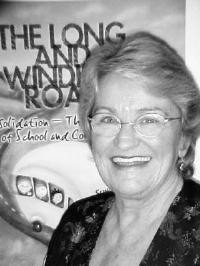 By Dianne Weaver By Dianne Weaver
Challenge WV Coordinator Linda Martin (right) says West Virginia's education policy is still based on an obsolete model.
"It is a message Challenge has repeated a thousand times, and will continue to repeat," Martin said.
"Challenge has a mission not only to get our educational leaders to believe the research, but to inform the citizens of the state," she said.
"We've done a pretty good job educating the public, but officialdom has a vested interest in going down the wrong path."
Martin contends few states have beaten a path to school consolidation faster than West Virginia.
She cited a recent grassroots bill moved forward by the House Education Committee and almost unanimously passed by the House. "The legislation would have returned a little power to communities to decide about consolidation, allowing [citizens] a vote," Martin said.
Members of the House of Delegates were responding to their constituents, who are tired of the state's bloody hammer being used on their local schools.
House Education chairman Sen. Robert Plymale stopped the bill from moving forward.
"He used Lloyd Jackson's old saw that the decision to consolidate is always made by local school boards," said Martin, "Everyone knows that local school boards are held hostage by the School Building Authority."
RESEARCH SUPPORTS COMMUNITY MODEL
Martin continues to tell state residents they live in the 21st century age of information, but education policy decisions are being made by people stuck in the 20th century industrial age.
"The industrial model that guides them includes 'economies of scale', and that's what they use to decide where they will build larger schools while moving children further and further from
the communities where they live," Martin said.
Martin says she sounds like a broken record - "State officials cannot be so uninformed as to not know what all the research shows - small schools provide a better education, higher graduation
rates, lower dropout rates, and higher achievement."
During nearly a decade of Challenge WV, the research piles up showing
small schools are better, at the same time educational bureaucrats ignore the thousands of kids age four and up who are being placed on bus rides of an hour and more one-way.
West Virginia spends more money transporting students than any other state.
"Today information is the predator and we are the prey," Martin said. "There is more information available than any of us needs or can consume. Much of it is inaccurate and sometimes even harmful to us. Our children need to learn to be thinkers."
WAL-MARTING OUR CHILDREN?
"What enables us to make those selections is being connected with and
involved in the real life and work of our communities, surrounded by
people who know us and interact with us," she said.
Martin and Challenge WV fellows adamantly believe that community people will help children "read their reality so they can write their own history and improve their world in the 21st century."
Thomas Ramey of Challenge said "Our schools are rapidly being removed from communities. They're all out on the four-lane roads like Wal-Marts. We're 'Wal-Marting' our children."
Author Jonathan Kozol has written that our public schools
are often "prisoners of minds." Schools are starting to look more like prisons, with solutions offered to address school violence like
metal detectors, identification tags, holding rooms and police officers.
Mary Anne Raywid, respected professor at Hofstra University, said students are more satisfied with small schools, fewer of them drop out and they behave better in small schools.
In addition, she says disadvantaged students particularly need the small school setting.
Martin says there are many studies that show school size is the most important predictor of school violence.
"The school where the metal detectors have been installed in McDowell is the consolidated school. They're not needed at the small schools," said community school advocate Mike Carter.
Researcher Craig Howley of the Appalachia Educational Laboratory in Charleston, WV, notes that school size exerts a "unique influence on academic accomplishments with a strong negative relationship linking the two: the larger the school, the lower the student achievement rates."
Martin concluded "This is not about nostalgia. This is about the best way to educate our kids."
| 


